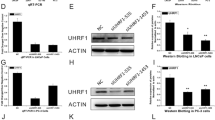Abstract
Purpose
XPA-210 is a proliferation marker derived from Thymidine kinase-1. It is of clinical significance in kidney, breast, and bladder cancer. There are no data available for XPA-210 in prostate cancer (PC). Herein, we aim to determine the clinical usefulness of XPA-210 in PC.
Materials and methods
In a retrospective study, cancer and benign tissue samples of 103 patients (median age 65 years, median PSA 9.04 ng/ml, median Gleason score 6) who underwent prostatectomy were constructed to a tissue micro array and stained for XPA-210. Semi-quantitative results were correlated with pathological and clinical data by Wilcoxon–Kruskall–Wallis and linear regression analysis. Expression levels in PC were correlated between the time of biochemical recurrence and the time to development of metastasis by the Kaplan–Meier method. Multivariate analysis was done to correlate those with the resection status.
Results
Mean staining score was 0.51–0.14 for tumor and benign tissue (P < 0.0001). Tumor staining score was significantly associated with Gleason score <6/≥6 (P < 0.0001) and T2/T >2 (P = 0.0007). When dividing the tumor score by the mean value, higher expression of XPA-210 was associated with a shorter time to biochemical recurrence (P = 0.003) and time to development of metastasis (P = 0.0061). Tumor staining (P = 0.0371) was an independent prognostic factor for biochemical relapse regardless of resection status.
Conclusions
XPA-210 is a new tissue-based prognostic marker for prostate cancer histopathology. It reliably differentiates tumor and normal prostatic tissue predicting biochemical relapse and onset of metastatic disease. XPA-210 might be clinically useful for individual decision-making in PC-treatment.

Similar content being viewed by others
References
O’Donnell H, Parker C (2008) What is low-risk prostate cancer and what is its natural history? World J Urol 26(5):415–422
Postma R et al (2005) Incidence and follow-up of patients with focal prostate carcinoma in 2 screening rounds after an interval of 4 years. Cancer 103(4):708–716
Zellweger T et al (2009) Tumour growth fraction measured by immunohistochemical staining of Ki67 is an independent prognostic factor in preoperative prostate biopsies with small-volume or low-grade prostate cancer. Int J Cancer 124(9):2116–2123
Nagao K et al (2011) Ki67 and BUBR1 may discriminate clinically insignificant prostate cancer in the PSA range <4 ng/ml. Jpn J Clin Oncol 41:555–564
Hannigan BM et al (1993) Thymidine kinases: the enzymes and their clinical usefulness. Cancer Biother 8(3):189–197
Petty EM et al (1996) FISH localization of the soluble thymidine kinase gene (TK1) to human 17q25, a region of chromosomal loss in sporadic breast tumors. Cytogenet Cell Genet 72(4):319–321
Sherley JL, Kelly TJ (1988) Regulation of human thymidine kinase during the cell cycle. J Biol Chem 263(17):8350–8358
Broet P et al (2001) Thymidine kinase as a proliferative marker: clinical relevance in 1,692 primary breast cancer patients. J Clin Oncol 19(11):2778–2787
Chen Y et al (2010) Serum thymidine kinase 1 correlates to clinical stages and clinical reactions and monitors the outcome of therapy of 1,247 cancer patients in routine clinical settings. Int J Clin Oncol 15(4):359–368
Zhang J et al (2006) Thymidine kinase 1: a proliferation marker for determining prognosis and monitoring the surgical outcome of primary bladder carcinoma patients. Oncol Rep 15(2):455–461
Gakis G et al (2010) XPA-210: a new proliferation marker to characterize tumor biology and progression of renal cell carcinoma. World J Urol
Mao Y et al (2005) Expression of cell proliferating genes in patients with non-small cell lung cancer by immunohistochemistry and cDNA profiling. Oncol Rep 13(5):837–846
Wang N et al (2001) Investigation on cell proliferation with a new antibody against thymidine kinase 1. Anal Cell Pathol 23(1):11–19
He Q et al (2004) Cytosolic thymidine kinase is a specific histopathologic tumour marker for breast carcinomas. Int J Oncol 25(4):945–953
Vogel UF (2008) Simple, inexpensive and precise paraffin tissue microarrays constructed with predrilled ordinary steel embedding moulds. Histopathology 52(2):255–256
Vogel UF (2009) The production of cast recipient blocks for paraffin tissue microarrays using conventional steel embedding moulds. Histopathology 55(4):470–472
Boccon-Gibod L et al (2004) Management of prostate-specific antigen relapse in prostate cancer: a European consensus. Int J Clin Pract 58(4):382–390
Heidenreich A et al (2010) Imaging studies in metastatic urogenital cancer patients undergoing systemic therapy: recommendations of a multidisciplinary consensus meeting of the association of urological oncology of the german cancer society. Urol Int 85(1):1–10
Wu C et al (2003) Production and characterisation of a novel chicken IgY antibody raised against C-terminal peptide from human thymidine kinase 1. J Immunol Methods 277(1–2):157–169
Zou L et al (2002) The half-life of thymidine kinase 1 in serum measured by ECL dot blot: a potential marker for monitoring the response to surgery of patients with gastric cancer. Int J Biol Markers 17(2):135–140
Rove KO, Flaig TW (2010) A renaissance in the medical treatment of advanced prostate cancer. Oncology (Williston Park) 24(14): 1308–1313, 1318
Ekman P, Lewenhaupt A (1991) Serum tumour markers in human prostatic carcinoma. The value of a marker panel for prognostic information. Acta Oncol 30(2):173–175
Acknowledgments
Anne-Charlotte Aronsson from Arocell provided the peptide for performing the antibody specificity experiments.
Conflict of interest
The authors declare that they have no conflict of interest.
Author information
Authors and Affiliations
Corresponding author
Rights and permissions
About this article
Cite this article
Aufderklamm, S., Hennenlotter, J., Todenhoefer, T. et al. XPA-210: a new proliferation marker determines locally advanced prostate cancer and is a predictor of biochemical recurrence. World J Urol 30, 547–552 (2012). https://doi.org/10.1007/s00345-011-0768-y
Received:
Accepted:
Published:
Issue Date:
DOI: https://doi.org/10.1007/s00345-011-0768-y




